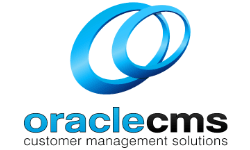Omnichannel Communication – the new customer service?
Customer Interaction Doesn’t Have To Stop at a Phone Call
Traditionally, customer service has revolved around speaking to customers on the phone.
When you mention the words customer service, it often conjures up images of call centres and a mass of call centre agents communicating with customers.
Unfortunately, many customers have negative connotations with this type of customer service.
They have spent time waiting on hold, listening to waiting music, and sometimes having to call back multiple times to get a solution to their problem.
Not surprisingly, customers aren’t particularly keen on calling a customer service line.
However, for customers and businesses alike there hasn’t really been an alternative.
Until now.
Recent developments in communication technology have opened up the doors to various communication methods that customers are embracing with open arms.
Instant messaging, email and SMS messages are all now commonly used by most people.
These alternative forms of communication provide a tremendous opportunity for new lines of customer service communication.
For the first time, companies can implement omnichannel customer support.
This new form of customer communication is the future of customer service and can help improve your business’s interactions with customers, boost customer satisfaction, and increase your profit margins.
This article aims to define omnichannel communication, identify its benefits, and outline the methods that omnichannel communication utilizes.
What is Omnichannel Communication?
Omnichannel communication is the cutting edge of B2C communication.
It has gained widespread acceptance as the best practice for customer communication because it delivers a streamlined and digital service.
Modern customers demand digital communication, and the pandemic has expedited this change.
Digital communication gives communications a more convenient and efficient way of communicating with your business and customer service representatives.
Alternative methods of communication, including social media and interactive chats, are the focal points of omnichannel customer support.
Businesses that fail to implement omnichannel communication will struggle to stay competitive.
Omnichannel customer interaction uses multiple methods and platforms to communicate and interact with customers.
Methods include social media, SMS messages, chats, email, and voice calls. The variety of options provides a more accessible and convenient customer service experience.
The Benefits of Omnichannel Customer Service
An effective omnichannel communication strategy gives customers several avenues to communicate their needs and get a solution.
By giving customers options and the freedom to choose, omnichannel customer service increases customer satisfaction and gives the customer a sense of empowerment.
Omnichannel support also improves the efficiency of your customer support agents.
Agents also have a variety of methods to interact with customers and have a consolidated communication system.
Agents will no longer have to juggle and search for information between different platforms.
An effective omnichannel communication strategy integrates all methods of communication.
Integration of communication methods improves operational efficiency, saves time, and provides higher-quality customer support providing a win-win for the business and the customer.
Phone-Plus Customer Service
It may be difficult to see a future of customer service that doesn’t rely entirely on phone calls.
However, this is the reality of omnichannel communication although it certainly doesn’t mean that phone calls will become a thing of the past.
Instead, omnichannel customer service seeks to create a phone+ method of communication. Instead of only phone calls, modern customer service will use all the available avenues to interact with and solve customers’ problems.
Integrating several methods of communication allows a modern business to receive continual information and feedback from its customers.
By improving the communication between a company and its customers, omnichannel customer service can positively impact engineering and product design, service and product development, and customer service.
This type of improvement is only possible through seamless and streamlined communication.
By embracing the customer feedback available through omnichannel communication, a business can avoid the trap of defensive customer service.
Defence customer service is the pattern of solving the same customer problems repeatedly.
In the long run, this method of customer service and problem-solving is inefficient, wastes the customer’s time, and is expensive.
Omnichannel communication allows a business to implement a more effective customer service method and can provide long-term solutions rather than just temporary solutions by integrating and connecting all forms of communication with customers and sharing that data with other parts of the business.
With omnichannel communication, a company can solve the root of the problem and prevent challenges from coming up in the future.
Omnichannel communication makes this possible by utilizing several methods of communication and collecting data.
4 Customer Service Alternatives to Phone Calls
1. Email
Email is one of the most popular methods of communicating with customers.
It is a convenient way to send and receive information and customer support, marketing, and sales can benefit from email communication with customers.
Consider some of these key statistics:
- The average person checks their email 15 times per day.
- People are more likely to check their work email than their personal email.
- The best time to email is between 10:00 am and 11:00 am.
- The average open rate for emails is 20.81%.
- The average click-through rate is 2.69%.
An omnichannel customer support system can automatically send emails to specific customers.
Additionally, with the proper systems, customers can send your customer service centres emails that are categorized, and your company can mine the email correspondences for helpful information.
This information can either lead to an automated email sequence or forward the appropriate information to a customer service agent that can then engage with the client.
The advantage of using email to interact with customers is that they do not have to stay on the phone or wait on hold.
They can engage with email at their leisure, making it more convenient and efficient for your business and the customer.
2. SMS
SMS, or Short Message Service, is a text message that can be sent from one phone to another and in the context of this article, SMS can also be sent from a business to a customer.
The open rate and click-through rate for SMS messages are far higher than other forms of communication, making it an ideal portion of an omnichannel communication system:
- The average open rate for SMS is 98%.
- The average click-through rate is 19%.
SMS messages are one of the most effective ways to engage with your customers and it’s certainly a quick and easy way to send a message.
It is also a non-intrusive form of communication. Customers can read and respond to an SMS at their convenience.
And as many individuals view SMS messages as highly important and personal, they can be an excellent way to engage consistently and authentically with customers.
SMS Messaging can be an effective way to resolve customer service inquiries and send follow-up messages, promotions, and check-ins with customers and used well, they can be one of the most effective channels that can positively impact your business.
3. WhatsApp
WhatsApp is a messaging app for smartphones that allows you to send text messages, videos, and pictures and has over 1 billion active users.
Customer support, marketing, and sales can also use WhatsApp as a part of their omnichannel communication strategy.
The advantage of using WhatsApp to interact with customers is that it is a quick and easy way to send a message. It is also a non-intrusive form of communication.
Customers can read and respond to a WhatsApp message at their convenience.
One key advantage of WhatsApp over other communication methods is that it does not require cellular reception – users can access WhatsApp over an internet connection.
Additionally, it can be accessed abroad, which means you can stay in contact with your customers even if they are travelling overseas.
Finally, WhatsApp offers a variety of mediums for communicating with your customers such as text, voice notes, and calls to keep in contact with your customers.
4. Facebook Messenger
Facebook Messenger is a messaging app that is part of Facebook and has over 1.3 billion active users.
It can be used for customer support, marketing, and sales when interacting with customers and is a quick and easy way to send a message.
Like WhatsApp, Facebook Messenger allows your business to communicate with your customers in several ways such as text, voice notes, and calls with both parties able to use the same methods.
Since it is a popular social media platform, your omnichannel communications with your customers can lead to free advertising.
Your customers can post and share their experiences speaking with you on their Facebook profiles. Free advertising is an added benefit of using omnichannel communication through Facebook messenger.
Final Thoughts
There are many alternatives to using phone calls to engage with customers including email, SMS, WhatsApp, and Facebook Messenger with each channel offering its advantages.
Choosing the right one (or all of them) will play a critical component in your omnichannel communication strategy and ultimately finding the right mix of channels that will provide your business with the best customer engagement should be the ultimate aim for long-term business success.
Ensuring your business has the right Cloud-based omnichannel solution will enable you to provide superior customer service and reduce the frustration and complexity of trying to manage all your customer channels over different platforms so take the time to research the available options and make sure you ultimately choose a technology platform or partner that is capable of growing with your business.
Of course, just having the technology doesn’t magically fix all your issues so make sure you also engage with your customers to find out what they need, and continue to work on your internal processes and procedures to provide the best outcomes for your customers and your business.


















